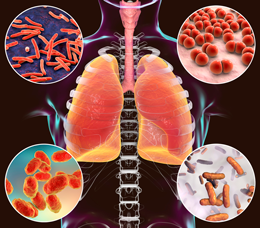
- This event has passed.
Strategies to Improve Diagnosis and Treatment of Nontuberculous Mycobacterial Lung Disease
Mar 17, 2022
Event Navigation

- More than 200 species of nontuberculous mycobacteria exist that produce both pulmonary and extrapulmonary disease
- According to the National Managed Care Claims Database (Optum), the prevalence of NTM-LD is increasing, and approximately 27 million individuals have the disease
- Risk factors for NTM-LD include underlying conditions (eg, CF/CFTR anomalies, AAT anomalies, COPD, pneumoconiosis, collagen vascular disease, bronchiectasis, TNF alpha antagonists, alveolar proteinosis, chronic aspiration), significant environmental exposures (eg, aerosolized soil and water, endemic areas), and innate host issues (eg, postmenopausal women, thin women with distinct body habitus, predisposition to hypersensitivity)
- Different clinical phenotypes for nodular/bronchiectatic and fibrocavitary NTM-LD disease include age, sex, body type, and smoking status
- Median time from symptom onset to diagnosis is 10 months with a range of 1 month to 6 years
- According to the 2020 ATS/ERS/ESCMID/IDSA clinical practice guidelines for NTM-LD, a 3-drug, macrolide-containing regimen is recommended and can be administered intermittently (noncavitary) or daily (cavitary); parenteral amikacin (including amikacin liposome inhalation solution) or streptomycin is suggested in patients with cavitary, extensive bronchiectatic, or macrolide-resistant disease
- In patients who meet the diagnostic criteria for NTM-LD, treatment should be started (ie, rather than watchful waiting), especially in the context of positive acid-fast bacilli sputum smears and/or cavitary lung disease
- Factors related to disease progression include bacterial load (ie, smear positive) and radiographic extent of disease; other predictors are older age, low BMI (< 18.5), comorbidities, low albumin, anemia, and elevated inflammatory indices
- Patients face many challenges with NTM-LD and experience real fears and struggles and losses in quality of life; it is important to share goals, set expectations, and provide education on adverse event management




